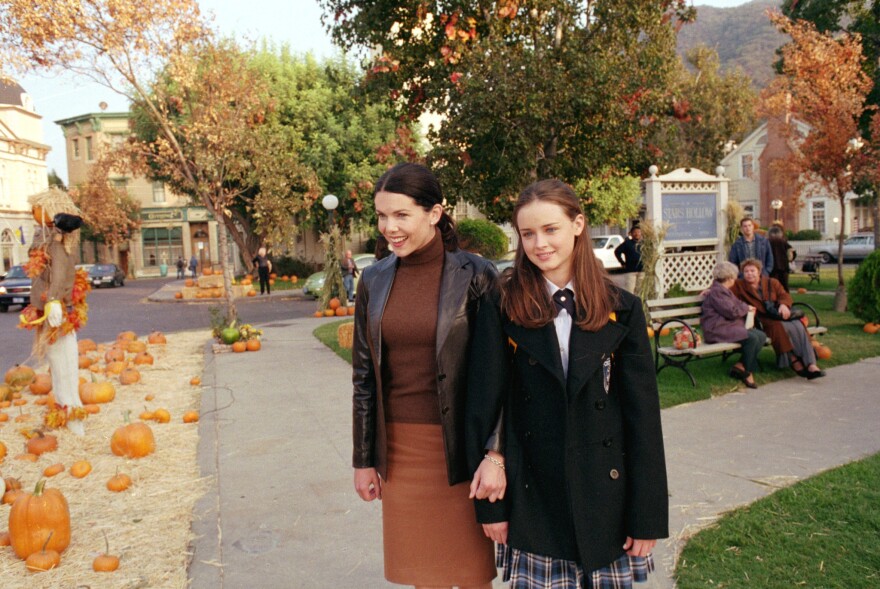With our free press under threat and federal funding for public media gone, your support matters more than ever. Help keep the LAist newsroom strong, become a monthly member or increase your support today.
How the LA-made ‘Gilmore Girls’ (now 25!) became synonymous with fall

Gilmore Girls turns 25 this weekend!
The WB dramedy set in a fictional small town in Connecticut went off the air in 2007, but in the years since, it has spawned multiple rewatch podcasts and a 2016 Netflix revival and has become so associated with autumn that it’s all over social media every fall.
Creating that East Coast autumnal vibe on the Warner Bros. lot in Southern California, though, where the series was filmed, was no small task.
“You're in Burbank, and you have California sort of non-seasons,” said production designer Rachel Kamerman, who worked on the series from 2003 to 2006. “And you've gotta do a four-season show.”
And even though she and the crew no doubt succeeded in the transformation, she has occasionally questioned whether it was accurate enough.
“Sometimes, I'm enamored by what we did fall-wise, and sometimes, I look at it now, and I grew up in the Midwest, and my husband's from Connecticut, so I know what fall really feels like,” Kamerman said. “So sometimes, I wish it was a little more perfect, but we did what we could within our budget and the quick turnaround.”
The fact that the show has become so closely associated with fall and so beloved, she says: “It's huge. It feels to me bigger now than when we were on the lot and filming it. And the recognition is bigger. It's a really lovely surprise to all of us how it's really transcended over the years.”
Turning Burbank into Stars Hollow
When it came to creating the feeling of an East Coast fall in Southern California, Kamerman said much of it was helped by filming on “Midwest Street” on the Warner Bros. lot, which is intentionally meant to be able to transform into “Anytown, USA.” It’s now most closely associated with Gilmore Girls but has been used for decades for shows like The Dukes of Hazzard (and Pretty Little Liars, which Kamerman also worked on) and movies like The Music Man.

“ I would consider it that whole exterior area [where] you can do a 360 and feel like you are in either a residential area or a sweet, quaint downtown.”
But the fall of it all still posed a problem. (Winter, too, involved using mashed potato flakes for snow and cutting board material for the “ice” of a skating rink.)
Some extreme measures had to be taken on the trees surrounding the gazebo that features prominently in the series.
“We had a fantastic greens department with Warner Bros., and they would go up on cherry pickers and pluck leaves off and put silks [i.e., fake leaves] in.”
What’s behind the show’s lasting cultural impact?
Kamerman’s theory for the show’s lasting impact has to do with the look and feel of it.
“I think everybody wants to kind of feel safe in the world,” she said. “And even though you know that there's strife between Lorelai and her parents and all the other kinds of things that are happening, there's like a visual safety and that coziness that I think is just imperative for that show, and that small town charm.”
The unique ‘pros’ of filming in LA
Despite the need to do things like replace real leaves with fake red and yellow ones, Kamerman said there also were distinct advantages to filming in L.A.
“L.A. gave us the magic of Hollywood and the magic of filming on a studio lot,” she said. “You can't turn around a show in seven days with new sets unless you've got people that know how to build sets and paint sets and shop out sets. The resources and the skilled people that are members of the unions here, there’s nothing like it.”
How to celebrate the show’s anniversary in LA
- On Saturday and Sunday, The Grove is putting on a Stars Hollow experience for the 25th anniversary — with photo opportunities inside a replica of the show’s gazebo and Luke’s Diner.
- You can see “Midwest Street” and Gilmore Girls-related memorabilia in person on the Warner Bros. Studio Tour in Burbank (though sometimes the street is closed off for filming).
- This winter, the studio is bringing back its immersive “Holidays Made Here” event (Dec. 18-Jan. 4), which features special set visits inside Lorelai and Rory’s house, Luke’s Diner, the Dragonfly Inn and the newly rebuilt Miss Patty’s School of Ballet.









